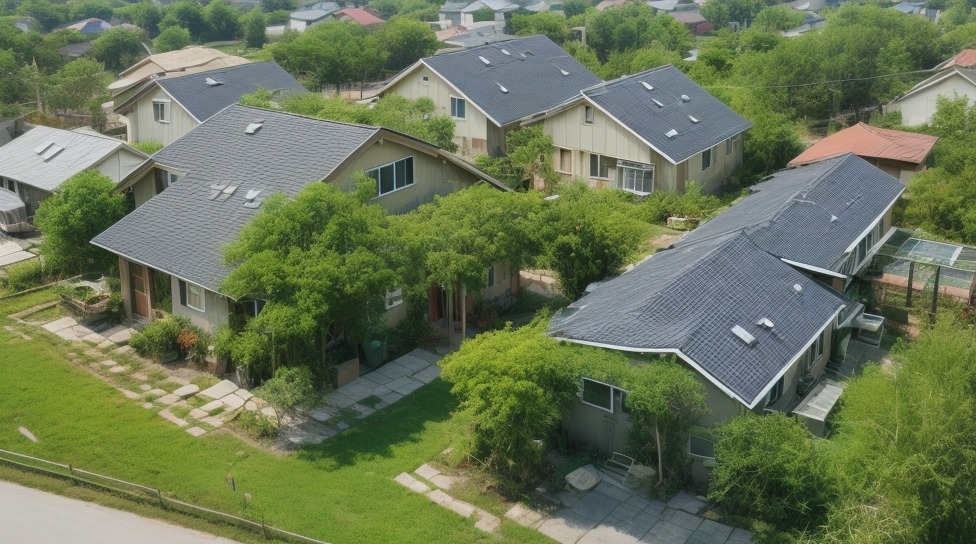What is Sustainable Living?

Welcome to our blog! Today, we’re going to explore the concept of sustainable living. In this day and age, it’s becoming increasingly important for us to consider our impact on the environment and make conscious choices that benefit not only ourselves, but also the planet we call home. With that in mind, we’ll be delving into the topic of sustainable living and discussing what it means, why it’s important, and how we can all make small changes to live more sustainably. So, let’s get started!
Understanding the Concept
Sustainable living is a lifestyle choice that aims to minimize our impact on the environment and conserve resources for future generations. It involves making conscious decisions and adopting practices that are environmentally friendly, socially responsible, and economically viable. By embracing sustainable living, individuals can contribute to the overall well-being of the planet, create a healthier and more sustainable future, and reduce their carbon footprint.
Benefits of Sustainable Living
Embracing sustainable living offers a wide range of benefits that extend beyond just environmental protection.
Let’s explore some of the significant advantages of incorporating sustainable practices into our everyday lives:
Environmental Preservation: By adopting sustainable living practices, individuals contribute to the preservation of natural resources, promote biodiversity, and protect ecosystems. Reduced energy consumption, waste management, and the use of renewable resources help in minimizing environmental degradation and preserving the Earth’s delicate balance.
Financial Savings: Sustainable living can lead to cost savings by reducing energy and water consumption, minimizing waste generation, and embracing a cyclical economy. Energy-efficient appliances, water-saving technologies, and conscious consumption habits not only benefit the environment but also result in lower utility bills and long-term financial savings.
Improved Health and Well-being: Sustainable living promotes a healthier lifestyle by encouraging the consumption of organic and locally sourced food, reducing exposure to harmful chemicals, and adopting clean energy alternatives. Additionally, walking or cycling instead of driving, using public transportation, and connecting with nature can improve physical fitness and mental well-being.
Reduced Carbon Footprint: Sustainable practices help individuals reduce their carbon footprint by minimizing greenhouse gas emissions that contribute to climate change. Energy-efficient homes, renewable energy sources, and sustainable transportation options all play a significant role in reducing the overall carbon emissions and mitigating climate-related risks.
Types of Sustainable Living
Sustainable living encompasses various aspects of life and can be practiced in different ways.
Some common types of sustainable living include:
Green Energy: Using renewable energy sources like solar, wind, or hydropower instead of relying on fossil fuels.
Green Building: Constructing or renovating buildings using sustainable materials, implementing energy-efficient design, and utilizing smart technologies to reduce energy consumption.
Eco-friendly Transportation: Opting for sustainable transportation alternatives such as public transit, carpooling, cycling, or walking to reduce reliance on private vehicles and minimize greenhouse gas emissions.
Sustainable Food Choices: Emphasizing locally sourced, organic, and seasonal food options to support local farmers, reduce the carbon footprint associated with long-distance transportation, and promote healthier eating habits.
Waste Reduction: Implementing strategies to reduce waste generation by recycling, composting, and minimizing the use of single-use plastics and packaging.
Water Conservation: Conserving water by using efficient fixtures, reducing water waste, and capturing rainwater for non-potable use.
Ethical Consumption: Making informed choices that support fair-trade, cruelty-free, and environmentally responsible products and companies.
How to Achieve Sustainable Living
Achieving sustainable living requires making conscious choices and adopting environmentally friendly practices in various areas of life.
Here are some key steps to help you transition into a more sustainable lifestyle:
Assess Your Current Lifestyle
Begin by examining your current habits and identifying areas where you can make sustainable changes. This might include analyzing your energy consumption, waste generation, and commuting patterns.
Set Sustainable Goals
Define clear and achievable goals that align with your values and priorities. Whether it’s reducing energy consumption, minimizing waste, or adopting sustainable transportation, having specific targets can guide your sustainable living journey.
Reduce Energy Consumption
Opt for energy-efficient appliances, turn off lights and electronics when not in use, utilize natural lighting, and insulate your home to reduce heat loss or gain. Consider switching to renewable energy sources like solar panels.
Conserve Water
Conserve Water: Install water-efficient fixtures, repair leaks promptly, collect and use rainwater for non-potable purposes, and practice mindful water usage habits like taking shorter showers.
Minimize Waste Generation
Follow the principles of reduce, reuse, and recycle. Avoid single-use plastics, opt for reusable alternatives, compost organic waste, and recycle as much as possible. Embrace a minimalist mindset and focus on conscious consumption.
Embrace Sustainable Transportation
Opt for public transportation, carpooling, biking, or walking when feasible. If you need a vehicle, consider choosing fuel-efficient or electric options.
Support Local and Sustainable Products
Make informed choices while shopping, supporting local farmers, choosing organic and fair-trade products, and favoring companies that align with sustainable practices.
Educate and Engage
Spread awareness about sustainable living to your friends, family, and community, and engage in discussions and initiatives related to sustainability. Collective actions have a broader impact on the environment.
By following these steps, you can gradually transition into a more sustainable lifestyle, contribute to a greener future, and inspire others to do the same.
Steps to a Sustainable Home
Creating a sustainable home is a vital part of sustainable living. Our homes account for a significant portion of our energy consumption, waste generation, and water usage.
Here are some essential steps to transform your home into a more sustainable and eco-friendly space:
1. Energy Efficiency
Improving energy efficiency in your home not only helps reduce your carbon footprint but also leads to significant cost savings. Here is why energy efficiency matters, and some tips for achieving it:
– Importance of Energy Efficiency
Energy efficiency is crucial for sustainable living because it reduces the demand for fossil fuels, decreases greenhouse gas emissions, and helps combat climate change. By adopting energy-efficient practices, such as choosing energy-efficient appliances, insulating your home, and using natural lighting, you can lower your energy consumption and contribute to a more sustainable future.
– Tips for Improving Energy Efficiency
Upgrade to LED or CFL light bulbs: These bulbs use significantly less energy and last longer than traditional incandescent bulbs.
Insulate your home: Proper insulation can prevent heat loss in the winter and minimize heat gain in the summer, significantly reducing your heating and cooling costs.
Use smart power strips: These power strips automatically turn off power to standby devices, preventing energy wastage.
Unplug electronics: When not in use, unplug chargers, electronics, and appliances to eliminate phantom energy usage.
Utilize natural lighting: Open curtains or blinds during the day to take advantage of natural light and reduce the need for artificial lighting.
Opt for energy-efficient appliances: Look for appliances with the ENERGY STAR label, as they meet strict energy efficiency standards.
Install a programmable thermostat: This allows you to automatically adjust the temperature in your home based on your schedule, reducing energy consumption when you’re away.
2. Water Conservation
Water conservation plays a crucial role in sustainable living, as water scarcity is becoming an increasingly pressing issue in many parts of the world. Here’s why water conservation matters, along with some tips to help you conserve water at home:
– The Importance of Conserving Water
Conserving water is essential for sustaining ecosystems, ensuring access to clean water for all, and reducing energy consumption associated with water treatment and transportation. By adopting water-saving practices, you can minimize water waste and preserve this precious resource.
– Tips for Conserving Water
Fix leaks promptly: Even a small leak can waste a significant amount of water over time. Regularly check for leaks in faucets, toilets, and pipes, and repair them promptly.
Install water-efficient fixtures: Choose low-flow showerheads, faucets, and toilets to reduce water consumption without compromising functionality.
Collect rainwater: Install rain barrels to collect rainwater for non-potable purposes such as watering plants or cleaning.
Water plants strategically: Water plants in the early morning or late evening to reduce evaporation. Use efficient irrigation methods such as drip irrigation or soaker hoses instead of overhead sprinklers.
Use water-saving appliances: Choose energy-efficient washing machines and dishwashers that use less water per cycle.
Practice mindful water usage: Turn off the tap while brushing your teeth, limit shower time, and only run the dishwasher or washing machine with a full load.
3. Waste Reduction
Minimizing waste generation is an integral part of sustainable living.
Here’s why waste reduction matters, along with some tips to help you reduce waste at home:
– Why Waste Reduction is Essential
Reducing waste not only conserves natural resources but also minimizes pollution, saves energy, and reduces greenhouse gas emissions from landfills. By adopting waste reduction practices, you can contribute to a more circular economy and reduce the strain on the environment.
– Tips for Reducing Waste
Embrace the 3 R’s: Reduce, reuse, and recycle. Opt for reusable alternatives instead of single-use items, donate unwanted items, and recycle materials whenever possible.
Compost organic waste: Start a compost pile or use a compost bin to turn food scraps and yard waste into nutrient-rich compost for your garden.
Say no to plastic: Avoid single-use plastics such as plastic bags, straws, and water bottles. Instead, carry reusable bags, stainless steel straws, and refillable water bottles.
Buy in bulk and reduce packaging waste: Purchase items in bulk to minimize packaging waste. Choose products with minimal or recyclable packaging.
Choose durable and repairable products: Invest in high-quality products that can be repaired or refurbished instead of buying disposable or easily breakable items.
Plan meals and reduce food waste: Plan your meals in advance to minimize food waste. Use leftovers creatively and freeze excess food for future use.
Educate yourself: Stay informed about local recycling guidelines and composting practices to ensure proper waste disposal.
4. Sustainable Transportation
Choosing sustainable transportation options not only reduces emissions but also improves air quality and supports a healthier lifestyle.
Here’s why sustainable transportation matters, along with some tips to help you embrace it:
– The Significance of Sustainable Transportation
The transportation sector is a major contributor to greenhouse gas emissions and air pollution. By opting for sustainable transportation alternatives, we can reduce our carbon footprint, improve air quality, and promote more efficient use of resources.
– Tips for Sustainable Transportation
Utilize public transportation: Take advantage of buses, trains, or trams for your daily commute.
Share rides: Carpool with colleagues or neighbors, or consider ride-sharing services to reduce the number of vehicles on the road.
Opt for active transportation: Walk or cycle for short-distance trips. Not only do these options produce zero emissions, but they also promote physical fitness and mental well-being.
Choose fuel-efficient vehicles: If owning a vehicle is necessary, opt for fuel-efficient models or consider electric vehicles that produce zero tailpipe emissions.
Plan trips efficiently: Combine multiple errands into one trip to minimize driving distances and fuel consumption.
Advocate for sustainable transportation: Encourage local authorities to invest in public transportation infrastructure and bike lanes, and support initiatives that promote sustainable transportation options.
By implementing these steps, you can transform your home into a sustainable sanctuary, reduce your impact on the environment, and inspire others to embrace sustainable living.
https://serenity7wellness.com/index.php/2023/12/11/how-to-start-living-a-healthy-lifestyle/
Sustainable Living in Daily Life
Sustainable living goes beyond individual actions and can become an integral part of our daily lives.
Here are some practical ways to incorporate sustainability into your routine and make a lasting impact:
Adopt Minimalism: Practice mindful consumption, declutter your living space, and focus on owning fewer, but higher-quality items. This reduces waste and promotes conscious consumerism.
Support Local: Purchase from local businesses and farmers’ markets to reduce the carbon footprint associated with long-distance transportation and support the local economy.
Embrace Plant-Based Meals: Incorporate more plant-based meals into your diet to reduce the environmental impact of animal agriculture and promote a healthier lifestyle.
Reduce Food Waste: Plan meals, store food properly, and repurpose leftovers to minimize food waste.
Conserve Resources: Use resources efficiently by turning off lights, unplugging electronics, reducing water consumption, and reusing items whenever possible.
Learn and Engage: Stay informed about sustainability issues, educate yourself and others, and engage in community initiatives and sustainable practices.
Sustainable Living Challenges
While the benefits of sustainable living are clear, there are challenges and obstacles that can make adopting sustainable practices difficult.
Some common challenges include:
Cost: Initial investments in energy-efficient appliances or solar panels might seem expensive. However, they can lead to long-term cost savings through reduced utility bills.
Lack of Knowledge: Many people are unaware of sustainable living practices or the environmental consequences of their actions. Educating oneself and others about sustainable living is crucial for fostering change.
Accessibility: Sustainable options might not be readily available or affordable for everyone, particularly in certain regions or communities. It is important to advocate for and support initiatives that promote accessibility to sustainable alternatives for all.
Social Norms: Social pressure or societal norms can make it challenging to go against the grain and adopt sustainable practices. Overcoming such barriers requires persistence, raising awareness, and creating a community of like-minded individuals.
Sustainable Living Tips and Best Practices
To make sustainable living a part of your everyday life, here are some additional tips and best practices to consider:
Educate Yourself: Stay informed about environmental issues, follow reputable sources, and join sustainability-focused organizations or groups.
Take Small Steps: Sustainable living is a journey, and it’s okay to start small. Focus on one area at a time and gradually incorporate more sustainable practices into your routine.
Engage with Others: Share your knowledge, experiences, and challenges with friends, family, and your community. Engage in discussions and initiatives related to sustainability to inspire others and create a collective impact.
Lead by Example: Make sustainable choices visible and share your positive experiences and outcomes. This can motivate others to follow suit and create a ripple effect.
Continuously Evolve: Be open to new ideas, practices, and technologies. Sustainable living is an evolving field, and embracing innovation and progressive approaches is essential.
Wrap Up
Sustainable living is a mindset and a conscious choice that each individual can make to contribute to a more sustainable future. By understanding the concept, embracing sustainable practices in various aspects of life, and actively engaging in sustainable living challenges and initiatives, we can create a positive impact on the environment, society, and our own well-being. Remember, every small action counts, and together, we can build a greener and more sustainable world for generations to come.







